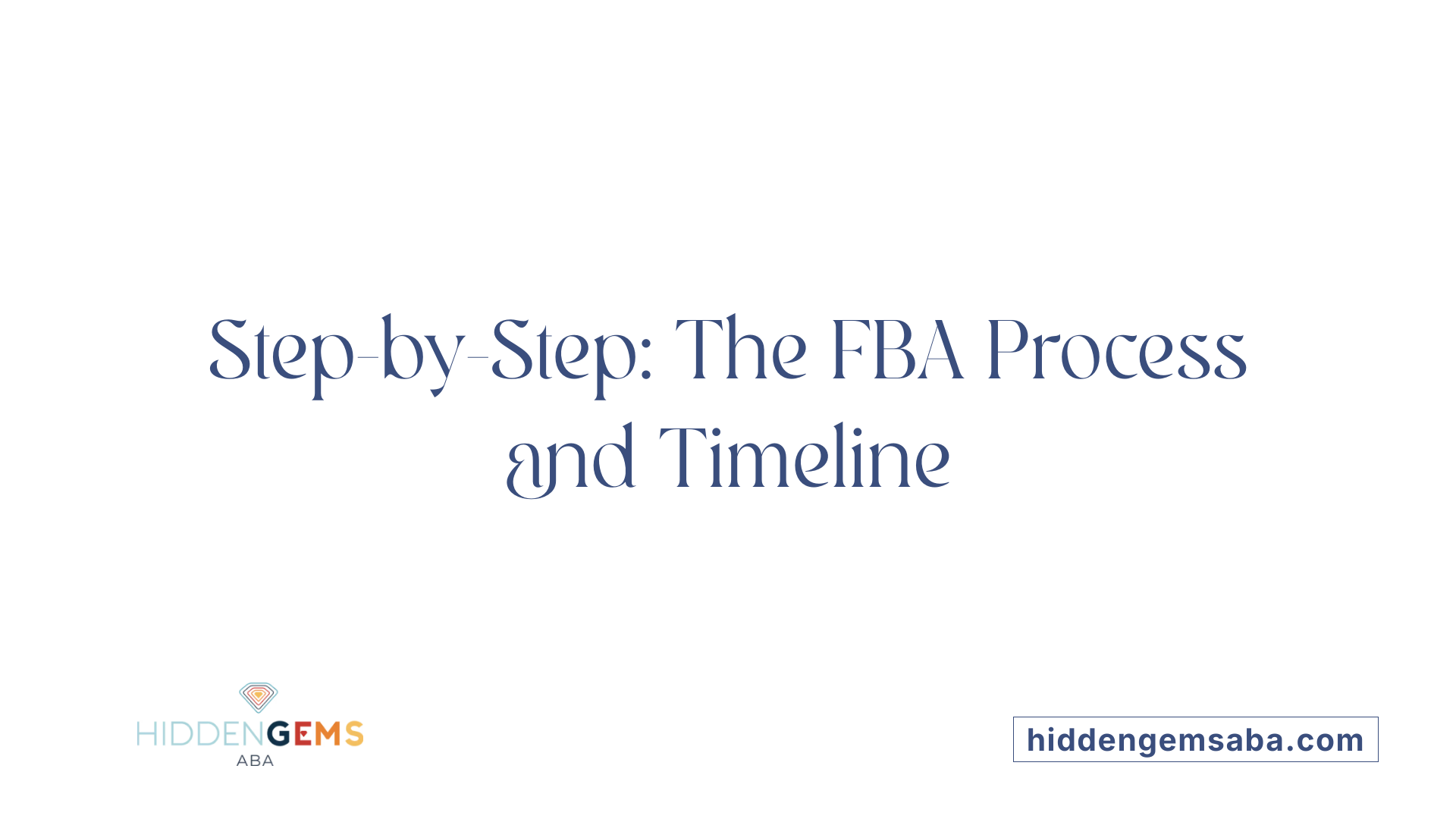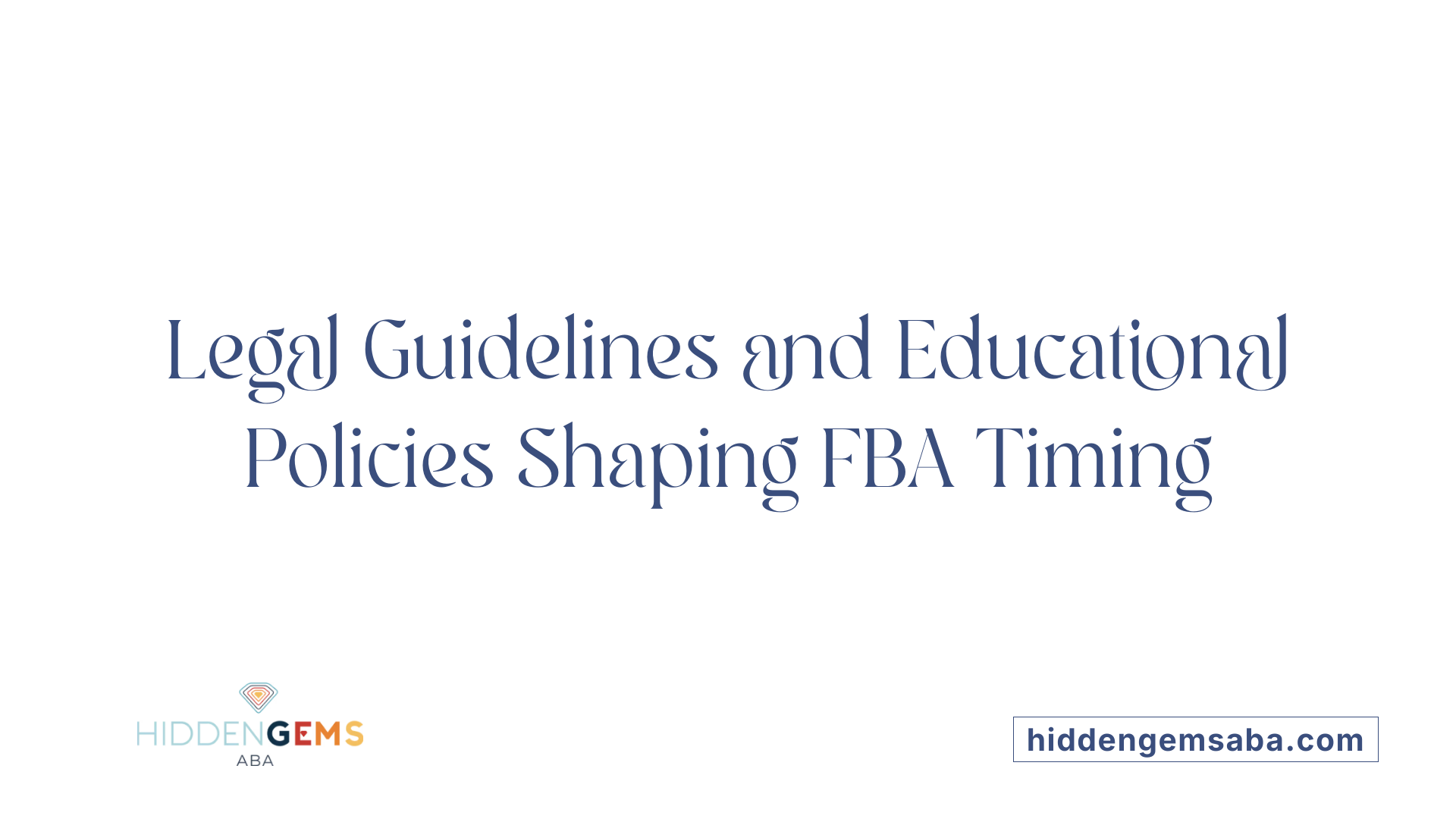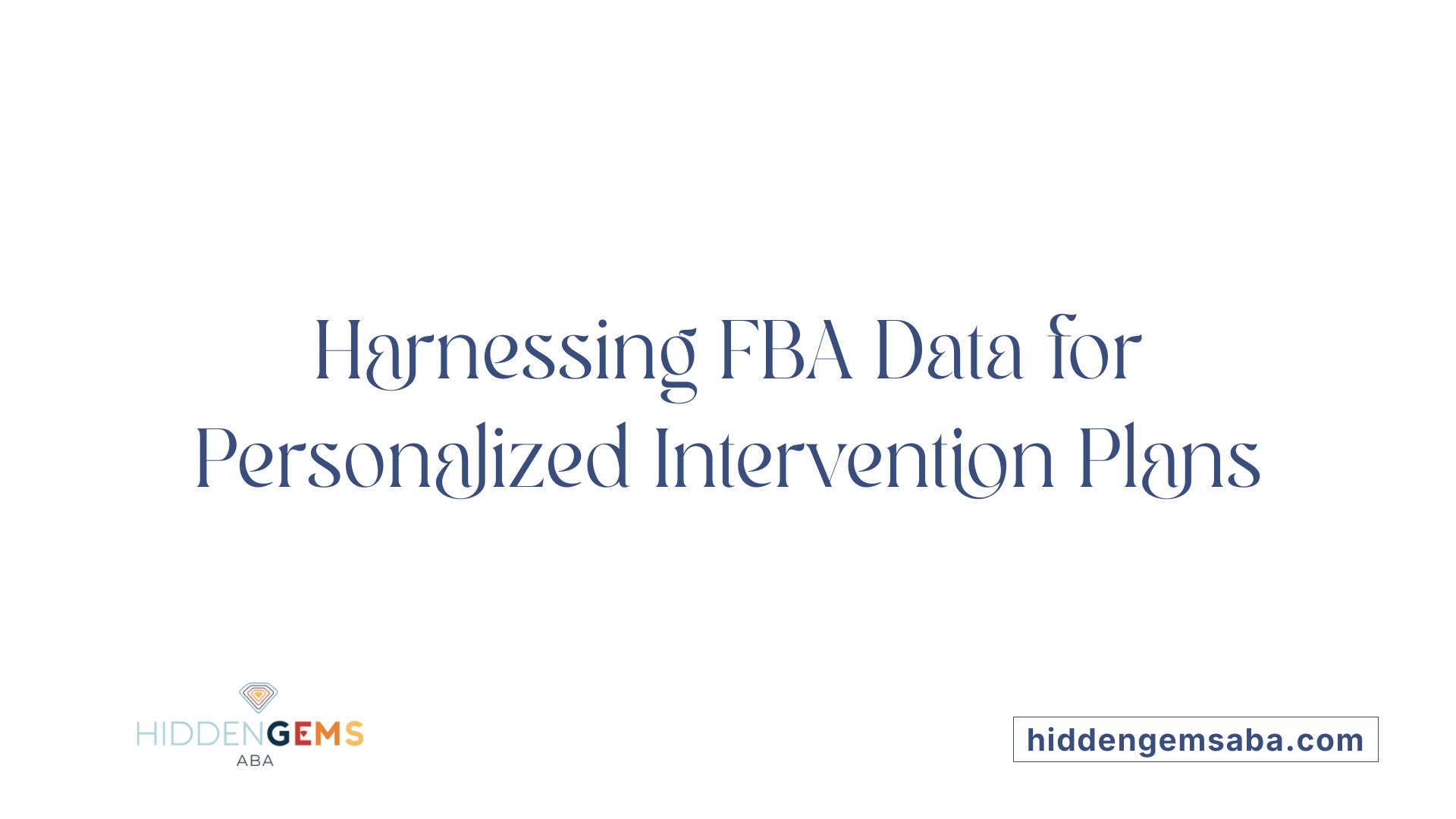Introduction to Functional Behavior Assessments
Functional Behavior Assessments (FBAs) are essential tools in autism therapy and behavioral analysis aimed at understanding the root causes of challenging behaviors. This article explores the duration, detailed process, and significance of FBAs, offering insights into how they support the development of effective intervention strategies for individuals with autism.
What Is a Functional Behavior Assessment and Why Is It Important?
Definition of FBA
A Functional Behavior Assessment (FBA) is a systematic and evidence-based process used to understand the reasons behind challenging behaviors, especially in children with autism. It involves gathering detailed information about the behavior in context, focusing on the antecedents (what happens before), the behavior itself, and the consequences (what happens after), often called the ABCs of behavior. This process helps identify the environmental factors that influence behavior and the function that the behavior serves for the individual.
Purpose of FBA in Autism Therapy
The primary purpose of an FBA is to uncover why a challenging behavior is occurring. Common functions include gaining attention, escaping difficult tasks or social situations, or seeking sensory input. Understanding these reasons allows professionals and families to develop targeted strategies that promote positive behavior and reduce problematic ones. For children with autism, this promotes self-determination, enhances communication, and improves overall quality of life.
Role of FBA in Applied Behavior Analysis (ABA)
Applied Behavior Analysis (ABA) is a science that uses learning principles to teach new skills and reduce behaviors that interfere with learning or social interactions. ABA therapy relies heavily on FBAs because they provide the critical data needed to design effective, individualized intervention plans. A well-conducted FBA guides ABA practitioners in selecting replacement behaviors, environmental modifications, and teaching strategies that align with the child's unique needs.
How FBA Informs Intervention Plans
The FBA process results in a hypothesis about the behavior's function, which informs the creation of a Behavioral Intervention Plan (BIP). This plan might include changing environmental triggers, teaching alternative skills, and adjusting consequences to reinforce desired behaviors. The BIP is practical and collaborative, involving parents, teachers, and professionals working together to implement strategies consistently and monitor progress. Through ongoing assessment and adjustment, interventions become more effective and personalized.
Overall, the FBA is not a one-time form but a dynamic process central to understanding and supporting individuals with autism within ABA therapy frameworks.
The Structured Process of Conducting an FBA and Its Timeframe

What are the stages and levels of FBA?
A Functional Behavior Assessment (FBA) is structured through three levels of assessment, each building on the previous one to gather detailed information about the challenging behaviors. These levels often include:
- Indirect Assessment: Reviewing records, conducting interviews, and collecting checklists to gather background and contextual info.
- Direct Observation: Systematic observation and recording of behavior in natural settings, often using tools like ABC (Antecedent-Behavior-Consequence) analysis.
- Functional Analysis (Analog Conditions): Experimentally testing hypotheses by manipulating environmental variables to confirm the function of behaviors.
This graduated approach allows for a thorough understanding of environmental influences and helps refine hypotheses about why behaviors occur.
What data collection methods are used in an FBA?
Multiple methods are employed to ensure comprehensive data collection, including:
- Interviews: Conducted with the student, parents, teachers, and caregivers to gather insights and contextual information.
- Record Reviews: Analysis of the student's educational and behavioral history.
- Direct Observations: Watching the behavior unfold naturally, focusing on antecedents, behaviors, and consequences (the ABCs).
- Scatterplots and Checklists: To document frequency, timing, and context of behaviors.
- Functional Analysis: If appropriate, conducting controlled assessments to test behavior hypotheses.
This variety of methods provides both qualitative and quantitative data for informed decision-making.
How long does it typically take to complete an FBA?
Completing a functional behavior assessment generally requires about 1½ hours of focused evaluation time. However, the overall process can extend over several days or weeks depending on the complexity of the behavior and the thoroughness of data gathering. Time is invested not just in initial data collection but also in reviewing records, conducting interviews, performing observations, developing hypotheses, and finalizing reports or interventions.
Why is an FBA considered an ongoing process rather than a one-time assessment?
An FBA is best viewed as a dynamic, ongoing process rather than a single event. After initial data collection and hypothesis formation, continuous monitoring and further observations are often needed to test and refine the intervention strategies. Behavior is influenced by changing environments and evolving student needs, making ongoing assessment and plan adjustment essential. This iterative nature ensures that interventions remain effective and relevant.
Engaging parents, teachers, and professionals collaboratively throughout the process also promotes sustained success and adherence to intervention goals.
| Aspect | Details | Purpose/Benefit |
|---|---|---|
| Stages of FBA | Indirect Assessment, Direct Observation, Functional Analysis | Structured, gradual deepening of understanding |
| Data Collection | Interviews, record reviews, ABC observations, checklists, functional analysis | Comprehensive, reliable behavior data |
| Typical Duration | Around 1.5 hours for assessment; days to weeks overall | Allows thorough, individualized assessment |
| Ongoing Nature | Iterative data collection, monitoring, and plan adjustment | Ensures intervention remains relevant and effective |
Legal and Educational Context Influencing FBA Timing

What Federal Laws Govern FBA Timelines?
Federal regulations, including the Individuals with Disabilities Education Act (IDEA) '97, mandate that Functional Behavior Assessments (FBAs) be conducted prior to or within 10 days of disciplinary actions that involve a removal exceeding 10 school days. These laws ensure timely assessments to appropriately address challenging behaviors connected to disabilities, facilitating legal compliance and educational fairness.
What Situations Typically Trigger an FBA, Especially in Disciplinary Cases?
An FBA is generally triggered when a student with disabilities exhibits challenging behavior that may result in a significant disciplinary consequence, such as a change of educational placement. Specifically, if a behavior leads to removal from the educational environment for more than 10 days, an FBA becomes necessary. This process helps identify the cause of behaviors and develop interventions that support the student's needs while informing disciplinary decisions.
What Is the Role of Parental Consent and Documentation Requirements?
Parental consent is typically required before conducting an FBA, aligning with federal mandates to respect family involvement in educational decision-making. Comprehensive documentation is crucial; this often includes records review, observation reports, behavior summaries, and detailed intervention plans. Proper documentation ensures clear communication among educators, parents, and professionals, and supports legal compliance.
How Are FBAs and Behavioral Intervention Plans (BIPs) Integrated into Individualized Education Programs (IEPs)?
FBAs and their resulting Behavioral Intervention Plans (BIPs) are integral components of a student's IEP. These assessments and plans are individualized, focusing on the student's ecological context and socially significant behaviors. By integrating these tools into the IEP, schools can provide targeted, hypothesis-driven interventions that promote positive behavioral changes and support educational success.
Personnel Qualifications and Their Impact on FBA Quality and Duration

Who Provides ABA Therapy and What Qualifications Do They Typically Have?
ABA therapy is predominantly delivered by licensed and certified professionals such as Board Certified Behavior Analysts (BCBAs) and trained behavioral therapists.
Qualifications of Professionals Conducting FBAs
Professionals conducting Functional Behavior Assessments (FBAs) generally possess a bachelor's degree in a relevant field, followed by a master's degree in Applied Behavior Analysis or related disciplines. They accumulate approximately 1,500 to 2,000 hours of supervised practical experience before certification.
Training and Certification Requirements for ABA Providers
To become certified ABA providers, these professionals must pass a rigorous exam administered by the Behavior Analyst Certification Board (BACB). This certification process ensures they maintain up-to-date knowledge and skills necessary for conducting comprehensive FBAs and implementing effective interventions.
Influence of Professional Expertise on FBA Thoroughness and Efficiency
The depth of expertise among professionals directly affects both the thoroughness and efficiency of the FBA process. Skilled assessors execute detailed data collection methods, including interviews, observations, and record reviews, all tailored to the individual’s needs. Their proficiency helps streamline the assessment, often completing a functional behavior assessment in approximately one and a half hours, yet allowing flexibility depending on complexity.
A well-trained professional's ability to accurately define target behaviors, analyze antecedents and consequences, and develop hypothesis-driven intervention plans greatly enhances the FBA’s success. Furthermore, their collaborative approach with parents, educators, and other specialists facilitates practical and adaptive behavioral intervention plans.
| Role | Qualification Requirements | Impact on FBA Process |
|---|---|---|
| Board Certified Behavior Analyst (BCBA) | Master's degree, supervised experience, BACB certification | Ensures comprehensive and evidence-based FBAs with accurate function identification |
| Behavioral Therapists/Technicians | Specialized training under supervision | Supports implementation and monitoring of intervention plans efficiently |
In sum, personnel qualifications critically influence the quality and duration of FBAs, reinforcing the necessity for trained professionals who follow standardized protocols and ethical guidelines.
How FBA Findings Drive Effective and Collaborative Intervention Strategies

How Use of FBA Data Guides Hypothesis-Based Intervention Plans
The data gathered during an FBA is critical for developing effective intervention strategies tailored to the specific behavior functions identified. By analyzing the antecedents, behaviors, and consequences (the ABCs), professionals create hypotheses about why a behavior occurs — such as gaining attention, avoiding tasks, or seeking sensory input. These hypotheses form the foundation of the Behavioral Intervention Plan (BIP), which targets environmental modifications, teaching new skills, and managing consequences to reduce challenging behaviors.
Collaboration Between Parents, Teachers, and Professionals
Successful intervention depends on a collaborative approach involving parents, teachers, and specialists. Parents contribute important insights and help implement strategies at home, while teachers provide observations in educational settings. Professionals trained in behavior analysis guide the assessment and intervention planning. This team works closely to ensure the intervention is practical and fits the child’s unique needs and ecological contexts.
Monitoring and Adjusting Interventions Using Ongoing Data
Since an FBA is an ongoing process rather than a one-time evaluation, regular monitoring of the behavior and intervention effectiveness is essential. Data collection continues after implementation, allowing the team to adjust strategies as needed to improve outcomes. This iterative process ensures that interventions remain responsive to the student's changing needs and promote positive behavior change.
Examples of Behavior Functions Identified by FBA
Common behavior functions revealed through FBA include:
- Attention seeking: Behaviors that gain social interaction or reactions from others.
- Escape/Avoidance: Behaviors aimed at avoiding tasks or undesired social situations.
- Sensory stimulation: Behaviors that fulfill sensory needs or preferences.
- Access to tangibles: Behaviors intended to obtain specific objects or activities. Understanding these functions allows for precise targeting in intervention plans, making them more effective and supportive of the child's self-determination.
Understanding the Benefits and Limitations of FBA and ABA Therapy

What Are the Benefits of Early and Comprehensive Functional Behavioral Assessments (FBA) for Individuals with Autism?
Early and thorough FBAs are essential for uncovering the causes behind challenging behaviors in children with autism. By analyzing antecedents, behaviors, and consequences—the ABCs—this process identifies environmental triggers and the function of behaviors such as gaining attention, escaping tasks, or sensory needs. This understanding guides the design of individualized, hypothesis-driven interventions that can significantly improve communication skills, social interactions, and daily living abilities.
Comprehensive FBAs lead to personalized treatment plans, promoting self-determination and improved quality of life. They encourage collaborative efforts among parents, teachers, and professionals, integrating practical training and ongoing monitoring. Early intervention with well-documented FBAs can reduce the intensity and frequency of challenging behaviors and support functional skill development, making behavior intervention plans (BIPs) more effective.
What Are Some Criticisms or Limitations of ABA and FBA?
Despite its evidence-based foundation, Applied Behavior Analysis (ABA) therapy is not without controversy. Critics point out that some ABA programs have historically used overly rigid or punitive techniques that may cause emotional distress and encourage autistic individuals to suppress their authentic selves.
Moreover, ABA’s focus on conforming to neurotypical behavior standards can undermine the individuality and well-being of those it serves. Limitations also arise from variability in the quality and expertise of providers, leading to inconsistent implementation and outcomes. These concerns highlight the need for ethical guidelines and oversight in behavior interventions.
Why Is Individualized and Respectful Behavior Analysis Important?
Behavior analysis must be tailored to each individual’s unique needs, strengths, and preferences to be effective and ethical. Respectful approaches emphasize collaboration with families, active involvement of the individual, and sensitivity to cultural and personal values.
FBA and ABA interventions should prioritize functional goals that enhance autonomy and dignity rather than mere compliance. This includes ensuring parental consent, ongoing communication, and flexibility to adjust plans as new information emerges. Well-trained professionals skilled in assessment and intervention techniques play a crucial role in achieving positive, meaningful outcomes for individuals with autism.
| Aspect | Benefit/Challenge | Details |
|---|---|---|
| Early FBA | Identifies behavior functions | Enables tailored, effective interventions leading to better communication and behavior |
| Comprehensive Assessment | Incorporates multiple data sources | Uses interviews, observations, records for accurate, individualized understanding |
| ABA Therapy | Improves functional skills | Focuses on communication, social skills, daily living, with monitored progress |
| Limitations of ABA | Risk of emotional distress and conformity | Potential for punitive practices and masking authentic behavior; quality varies |
| Respectful Approaches | Enhances individual dignity | Collaborative, culturally sensitive, prioritizes autonomy and ethically sound practices |
This careful balance of benefits and awareness of limitations ensures ongoing refinement of behavioral therapies to genuinely support the needs and rights of individuals with autism.
Summary and Final Thoughts on FBA Duration and Impact
The Functional Behavior Assessment is a critical, methodical process foundational to effective ABA therapy for individuals with autism. While the initial FBA session typically takes about an hour and a half, the overall assessment process may extend over several days or weeks depending on the complexity and the data required. Conducted by qualified professionals, FBAs are governed by legal mandates ensuring timely completion to inform behavioral intervention plans that improve life quality and independence. Despite its proven benefits, ABA and FBA carry limitations warranting thoughtful, individualized applications that respect each person's dignity and unique needs. Ultimately, understanding the time and care invested in FBAs reinforces the importance of these assessments in crafting meaningful, person-centered behavioral supports.
References
- Functional Behavior Assessment (FBA)
- Functional Behavioral Assessment and ...
- What is a Functional Behavior Assessment? Autism & ASD
- Understanding Functional Behavior Assessment
- Functional Behavior Assessment (FBA) Training Manual
- How to Become an Applied Behavior Analyst (ABA) Therapist
- How to Become an ABA Therapist - School of Education
- Applied Behavior Analysis (ABA)
- ABA Therapy Goals: 25 Practical Examples & Timelines





